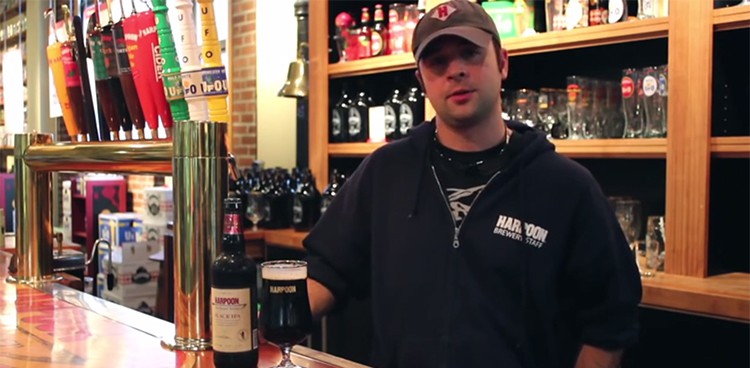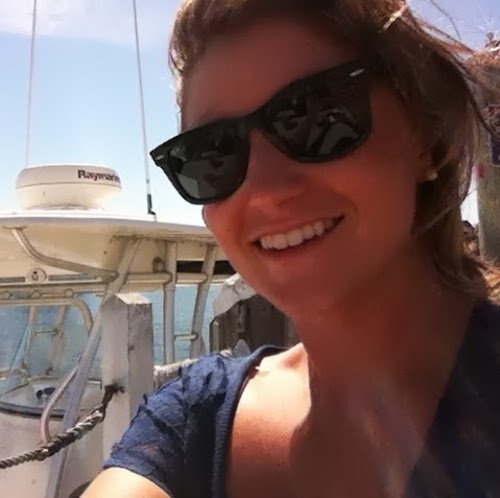
In this blog series, our summer intern Jackie will interview a variety of cheesemakers, mongers, and buyers, in order to get a glimpse into their day-to-day life. Follow along as Jackie goes behind the scenes and brings you the inside look on the cheese world.
Matt DeLuca was born and raised just south of the city of Boston, which Bostonites lovingly refer to as the “South Shore.” For college, Matt attended St. Michael’s in Burlington Vermont, where he studied journalism. After graduating in 2005 (and spending the year painting houses and drinking all the craft beer Vermont has to offer), Matt decided to move back to the South shore, and figure out his next step.
Since going to school and living in Vermont, Matt had developed a keen interest in beer and the craft beer movement in the United States. His first love was Long Trail Ale. Everything about it, down to the label and the brown color of it. He began his journey: Attempting to taste all the beer in the state. He even did his senior thesis on the history and evolution of craft brewing in Vermont. Matt, along with two friends, visited almost every brewery in Vermont—which is saying a lot! Vermont was then, and is still, the state with the most craft breweries per capita. He was able to not only visit almost all of the breweries, but interview the brewers and make a documentary. “That’s where I really fell in love with the brewing industry and kinda really got to know what it was about” However, the more we got to talking, Matt realized that his interest in beer was truly sparked at the young age of 16, when he was a sophomore in high school. More on that later.
Harpoon
As of November 2013, Matt will have worked at Harpoon Brewery for seven years! However, it wasn’t always such a glamorous gig. At the age of 24, Matt didn’t have any real, professional work experience, not to mention brewing experience. Luckily for him, back then Harpoon had a program known as the “bootcamp program” that was designed to encourage young people to get into the beer and brewing industry. Matt started out driving trucks and delivering kegs of beer all over the city of Boston. He then moved on to the production side, where he worked the bottling line and the racker, which is the machine that refills the kegs. The first nine months of working at Harpoon consisted of learning the ropes and figuring out how everything worked. He didn’t start working in the brew house until March of 2010. Thats when he really got into the “hot” side of brewing; actually coming up with recipes and brewing beer. Matt is one of only seven guys at Harpoon that hold the coveted title of “brewer.”
The Perks
As a brewer, Matt still finds himself working all over the brewery. He can be seen on forklifts grabbing bags of specialty malt, in the cooler grabbing imported hops, and at the computer executing procedures. By computer, I mean four screens with an overwhelming amount of figures, grids, and numbers on them, that somehow hold all of the information and power to brew every last barrel of beer. “It’s a nice mix of science, computers, and alchemy, it definitely keeps me entertained, I learn something new every day. The end result is beer, which is good. It’s pretty rewarding.”
Believe in or not, the free beer is not the most thrilling part about Matt’s job. In addition to Matt’s day-to-day tasks, he also gets to work at the beer festivals, tasting events, and beer dinners that Harpoon participates in. Just last February Matt was invited to New York for NYC Beer Week. Matt likes to get out of the brewery and meet the consumers, and establish new accounts with restaurants and bars. He enjoys getting to travel and to see what other breweries are doing. “It’s a constantly evolving industry. What might be hot now, might be kind of forgotten in ten years, or stuff that was popular two hundred years ago, may see a renaissance in the United States. The U.S. craft brewing scene has so much going on.”
Getting Creative
Harpoon has an incredibly large brewing capacity system where they brew most of their well known beers, including: Harpoon IPA, UFO White, and Octoberfest. However, in addition to large scale production, they have a miniature version that is mostly used for experimentation.
Though a lot of Matt’s job is executing recipes that are already foolproof, he spends a fair amount of time working on new recipes. On a regular basis, Matt’s boss, will circulate an email to all of brewers, asking for ideas for new beers. It is up to the brewers to come up with the recipe, find the ingredients, and figure out how to make it work. Additionally, different distributors will often approach them and ask for them to formulate a recipe for a specific style of beer that they may not already make.
Matt relies on software from BeerSmith to help him with the science side of formulating recipes. The program helps calculate how much of each ingredient he will need for a certain style of beer. It also gives him information about what the IBU (Internal Bitterness Units) should be, what the ABV (Alcohol by Volume) should be, and even what color the specific style of beer should be. A program like this isn’t as necessary for brewing on a small scale, like at home, but when you are brewing 100 barrels at a time, you want to make sure your math adds up.
Matt finds his inspiration for new brews mostly by going to local bars and stores and seeing what is new and popular. He also checks websites such as BeerAdvocate and BEERPULSE.COM a couple of times a week. “Everyone shares everything in the industry, which is really nice. There is a lot of communication and not a lot of secrets.”
Day-to-Day
As a brewer, Matt spends 60% of his day on the computer: Checking valves, answering prompts, maintaining temperatures, and just in general making sure everything is running smoothly. The remaining 40% of Matt’s job is spent on the brewing floor: Setting up the fermenters (yeast can be a very finicky organism), milling grain, and measuring out hops. The amount of physical labor the day requires generally depends on the beer that they are brewing. For instance, a beer like Harpoon IPA uses just 10 bags of specialty malt, where a beer like Pumpkin UFO requires 75 bags of malt and the addition of pumpkin purée! That’s a whole lot more opening, pouring, and mixing of ingredients that requires a whole lot more manpower.
Matt’s schedule is different every week, but he gave me a good look into what the first shift of the day looks like, which starts at 6:00 a.m. and ends at 2:00 p.m. On Friday, the first batch of grain that will be brewed on Monday is milled, so when Matt arrives at 6:00 a.m. on Monday morning, he logs onto the computer system and essentially hits “play.” The formula is initiated and the brewing process starts. Matt explained to me that it takes about six hours for the grain to become the wort; by heating it up and adding different hop varietals. It is first taken into the mash tun, then the water is added, the mixture is set to boil, put into the whirlpool, and eventually the wort is cooled down and mixed with the yeast to initiate fermentation. Does it sound like I’m speaking a different language? Maybe this will help.
Harpoon is a 24 hour brewery, meaning that they brew 24 hours a day and that there is always someone there. Once every six weeks, Matt does get stuck doing the graveyard shift, (6:00 p.m. until 2:00 a.m.) but he doesn’t mind. He likes that he gets to have the whole day to do whatever he wants, and it happens so rarely that it really doesn’t disrupt his schedule too much. A lot of his side work and responsibilities have to be done during regular business hours, so he usually works day shifts. In addition to brewing, Matt is in charge of ordering both the pale and wheat malts for the brewery.
Future
Matt loves the culture of working for a company like Harpoon—so you won’t see him leaving his post anytime soon—but someday he hopes to maybe open up his very own brewpub. Matt dreams of opening a small spot where all of the beer served is brewed on site and isn’t available anywhere else. He would love to do this somewhere like the South Shore, where nothing of the sort really exists.
Fun Facts:
- Though Matt attributes living in Vermont with sparking his interest in the craft beer industry, his first taste of any beer (other than Coors Light, which is what his Dad used to drink) was Catamount Pale Ale. His parents had a big New Year’s Eve party when he was in high school, and he “borrowed” a six pack to share with his friends. “It was just a simple pale ale, but back then, to my taste buds, it was something totally different and new. I kind of realized that there was a lot more out there with beer.”
- Matt used to dabble in homebrewing when he was first getting started, but now he prefers to keep the brewing at Harpoon. They have all of the equipment and ingredients he could ever need, and they give him creative freedom. What more could you ask for?
- Matt’s favorite part about his job is that he gets a lot of respect for what he does, and people are generally interested in his work. “Not every job has tours that go through and show people what you do for work. I find that pretty humbling.”
- Matt’s favorite beer (that Harpoon makes) is Harpoon IPA, which he describes as “a working man’s IPA”. He also really likes the Black IPA, that he actually created. “It is a blend between stouts and porters, which I really like, and IPA’s, which I also really like”. Look for it on shelves in six packs this fall and winter!
- Matt doesn’t consider himself to be a” foodie” at all. His favorite spots are neighborhood gems, like Rino’s Place in East Boston. He really appreciates good, solid, Italian food, even if it means he has to drink a non-craft beer with his chicken parmesan.
- Though Matt is a beer expert, he does not discriminate. The only thing you won’t find him drinking is Bud Light Lime or anything that resembles a Twisted Tea.
- Matt’s not a big liquor guy, but he enjoys a glass of Scotch every now and then. Such a classy guy.







